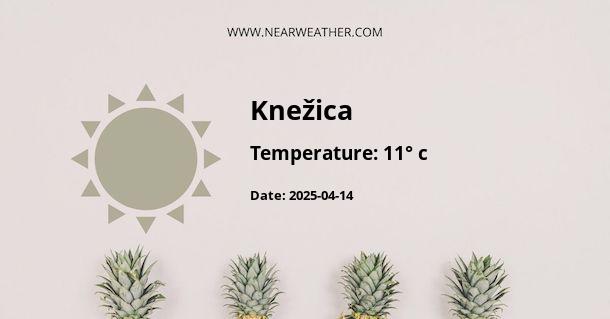Climate and Weather Overview of Knezica, Bosnia and Herzegovina
Knezica, a village located within Bosnia and Herzegovina, experiences a diverse climate influenced by the country's topographical variance. The general climate classification for Bosnia and Herzegovina is continental and Mediterranean, with local nuances in different regions, which also contribute to the unique weather patterns of places like Knezica.
Geographical Influence on Knezica's Climate
Knezica's weather is shaped considerably by its geographical location. Bosnia and Herzegovina itself is situated between 42 and 45 degrees north latitudes and 15 and 20 degrees east longitudes, contributing to its continental and Mediterranean climate divide.
Topographic Impacts
- Mountain Ranges: Large parts of the area are mountainous, which creates microclimates and has significant influence over the temperature and precipitation levels in Knezica.
- Proximity to the Adriatic Sea: Its distance from the Adriatic Sea also plays a fundamental role, where coastal influences can temper climate conditions, particularly in the wintertime.
Seasonal Weather Variability
The continental climate characteristics bring very distinct seasons, each with its unique weather patterns.
Spring Weather Patterns
During spring, Knezica begins warming with an increase in daily temperatures and a higher frequency of rain showers. This season is characterized by a mix of unpredictably mild and occasionally chilly weather, with flora rapidly coming to life.
Summer Climate Attributes
The summer months in Knezica are usually warm with temperatures that can sometimes reach high levels. Precipitation during these months tends to decrease, but occasional thunderstorms can occur, especially in the late afternoon or evening.
Autumn Temperature and Precipitation Trends
Autumn brings a steady decline in temperatures and an increase in rainfall, preparing the environment for the winter season. The weather can often be quite mild and enjoyable in the early part of autumn, known as Indian summers.
Winter Conditions
Winters are typically cold with snowfall. Knezica and its surroundings may experience significant snow during the peak winter months, thanks to the closeness of mountainous regions which encourages precipitation in the form of snow, particularly at higher altitudes.
Annual Weather Averages for Knezica
To provide a clearer picture of Knezica's climate, here is a table depicting average high and low temperatures, along with average rainfall.
| Month | Average High (°C) | Average Low (°C) | Average Precipitation (mm) |
|---|---|---|---|
| January | 3 | -3 | 75 |
| February | 5 | -2 | 65 |
| March | 10 | 1 | 70 |
| April | 15 | 5 | 75 |
| May | 20 | 9 | 85 |
| June | 24 | 13 | 85 |
| July | 27 | 15 | 75 |
| August | 27 | 15 | 70 |
| September | 22 | 11 | 80 |
| October | 16 | 7 | 85 |
| November | 10 | 2 | 95 |
| December | 4 | -1 | 90 |
Microclimates and Weather Events
Due to the varying terrain, Knezica may experience microclimates leading to localized weather events. This can include fog in valleys and sudden storms in higher elevations.
Extreme Weather Incidents
Though not frequent, Knezica is subject to occasional extreme weather events such as intense snowstorms or heatwaves. Such events are often influenced by broader climatic conditions such as the Arctic Oscillation or Mediterranean cyclones.
Climate Change Impact on Knezica
Climate change is having a noticeable impact on the weather patterns of Bosnia and Herzegovina. Studies have indicated shifts in temperature and precipitation patterns, with consequences such as more frequent heatwaves or altered snowfall in winter months. These changes can trigger a chain of ecological and socio-economic repercussions for Knezica and its inhabitants.
Adaptive Measures
To mitigate the effects of climate change, local governance and communities are encouraged to adopt adaptive measures, such as improving water retention, adjusting agricultural practices, and reinforcing infrastructure against extreme weather events.
Conclusion
In conclusion, Knezica's climate is marked by diverse weather patterns due to its continental and Mediterranean influences, geographical location, and topography. Understanding these patterns is vital for agriculture, infrastructure, and tourism development, which are integral to the local economy. Continued observation and research are essential in adapting to the evolving climatic scenarios posed by global climate change.
Professional Recommendations
To maximize the use of this climatic data and integrate it effectively into planning processes, professionals recommend:
- Seasonal weather preparedness: Ensuring that the local community and authorities are well-equipped to handle the weather changes each season brings.
- Climate impact assessments: Regularly updating data and projections related to climate change to guide policy and development.
- Sustainable development practices: Incorporating sustainable and eco-friendly methods in agriculture, construction, and energy to minimize local climate impact.
- Climate education: Raising awareness about the implications of climate change and promoting actions to reduce carbon footprints.
A - Knežica's Latitude is 45.102779 & Longitude is 16.677500.
A - Weather in Knežica is 11° today.
A - Climate Conditions in Knežica shows light rain today.
A - Humidity in Knežica is 76% today.
A - Wind speed in Knežica is 0.86 km/h, flowing at 165° wind direction. today.
